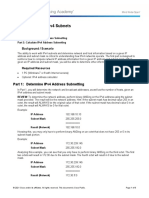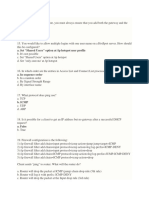John Lloyd Villafuerte
ECE-4B
IP (IPv4) Subnetting Exercises
Learning Objectives:
● Understand and learn the IP Address subnetting, and its practical
application in the computer networks.
Pre-requisites:
Completion of the topic: IP Addressing and Subnetting
Exercises:
Part A: Subnetting
Problem 1
Number of needed subnets: 14
Number of needed usable hosts: 14
Network Address: 192.10.10.0
Address class: Class C
Default subnet mask: 255.255.255.0
Custom subnet mask: 255.255.255.240
Total number of subnets: 16
Total number of host addresses: 16
Number of usable addresses: 14
Number of bits borrowed: 4
What is the 4th subnet range? 192.10.10.48 – 192.10.10.63
What is the subnet number for the 8th subnet? 192.10.10.112
What is the subnet broadcast address for the 13th subnet? 192.10.10.207
What are the assignable addresses for the 9th subnet? 192.10.10.129 – 192.10.10.142
Problem 2
Number of needed subnets: 1000
Number of needed usable hosts: 60
Network Address: 165.100.0.0
Page 1 of 4
� Address class: Class B
Default subnet mask: 255.255.0.0
Custom subnet mask: 255.255.255.192
Total number of subnets: 1024
Total number of host addresses: 64
Number of usable addresses: 62
Number of bits borrowed: 10
What is the 15th subnet range? 165.100.3.128 – 165.100.3.163
What is the subnet number for the 6th subnet? 165.100.1.64
What is the subnet broadcast address for the 6th subnet? 165.100.1.127
What are the assignable addresses for the 9th subnet? 165.100.2.1 – 165.100.2.62
Problem 3
Number of needed subnets: 2
Network Address: 195.223.50.0
Address class: Class C
Default subnet mask: 255.255.255.0
Custom subnet mask: 255.255.255.192
Total number of subnets: 4
Total number of host addresses: 64
Number of usable addresses: 62
Number of bits borrowed: 2
What is the 3rd subnet range? 192.223.50.128 – 192.223.50.191
What is the subnet number for the 2nd subnet? 192.223.50.64
What is the subnet broadcast address for the 1st subnet? 192.223.50.63
What are the assignable addresses for the 3rd subnet? 192.223.50.129 – 192.223.50.190
Problem 4
Number of needed subnets: 750
Network Address: 190.35.0.0
Address class: Class B
Default subnet mask: 255.255.0.0
Custom subnet mask: 255.255.255.192
Total number of subnets: 1024
Total number of host addresses: 64
Number of usable addresses: 62
Number of bits borrowed: 10
Page 2 of 4
� What is the 15th subnet range? 190.35.3.128 – 190.35.3.191
What is the subnet number for the 13th subnet? 190.35.3.0
What is the subnet broadcast address for the 10th subnet? 192.35.2.127
What are the assignable addresses for the 6th subnet? 192.35.1.65 – 192.35.1.126
Problem 5
Number of needed usable hosts: 6
Network Address: 126.0.0.0
Address class: Class A
Default subnet mask: 255.0.0.0
Custom subnet mask: 255.255.255.248
Total number of subnets: 2097152
Total number of host addresses: 8
Number of usable addresses: 6
Number of bits borrowed: 21
What is the 2nd subnet range? 126.0.0.8 – 126.0.0.15
What is the subnet number for the 5th subnet? 126.0.0.32
What is the subnet broadcast address for the 7th subnet? 126.0.0.55
What are the assignable addresses for the 10th subnet? 126.0.0.73 – 126.0.0.78
Part B: Practical Subnetting
Problem 1: Based on the information in the graphic shown, design a network addressing
scheme that will supply the minimum number of subnets, and allow enough extra subnets
and hosts for 100% growth in both areas. Each subnet on the graphic were encircle, answer
the questions below.
Address class: Class B
Custom subnet mask: Variable (VLSM: /25, /26, /27, /29)
Minimum number of subnets needed: 4
Extra subnets required for 100% growth: Already included in VLSM allocation
Page 3 of 4
�Total number of subnets needed: 4
Number of host addresses in the largest subnet group: 126
Number of addresses needed for 100% growth in the largest subnet: 120
Total number of addresses needed for the largest subnet: 128
IP address range for Research: 172.16.0.1 – 172.16.0.126
IP address range for Marketing: 172.16.0.129 – 172.16.0.190
IP address range for Management: 172.16.0.193 – 172.16.0.222
IP address range for Router A to Router B serial connection: 172.16.0.225 – 172.16.0.230
Problem 2: Based on the information in the graphic shown, design a network addressing
scheme that will supply the minimum number of hosts per subnet, and allow enough extra
subnets and hosts for 30% growth in all areas. Each subnet on the graphic were encircle,
answer the questions below.
Address class: Class B
Custom subnet mask: VLSM — /27 (255.255.255.224) for TechEd/English, /28 (255.255.255.240)
for Science, /30 (255.255.255.252) for serial links
Minimum number of subnets needed: 5
Extra subnets required for 30% growth: 0
Total number of subnets needed: 5
Number of host addresses in the largest subnet group: 30
Number of addresses needed for 30% growth in the largest subnet: 26
Total number of addresses needed for the largest subnet: 32
IP address range for Tech Ed: 135.126.0.1 – 135.126.0.30
IP address range for English: 135.126.0.33 – 135.126.0.62
IP address range for Science: 135.126.0.65 – 135.126.0.78
IP address range for Router A to Router B serial connection: 135.126.0.81 – 135.126.0.82
IP address range for Router A to Router B serial connection: 135.126.0.85 – 135.126.0.86
Page 4 of 4


































